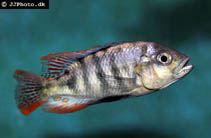| Family: |
Cichlidae (Cichlids), subfamily: Pseudocrenilabrinae |
| Max. size: |
9.4 cm SL (male/unsexed) |
| Environment: |
benthopelagic; freshwater; pH range: 8 - 8; dH range: 9 - 19 |
| Distribution: |
Africa: Lake Victoria and Victoria Nile. |
| Diagnosis: |
Dorsal spines (total): 15-16; Dorsal soft rays (total): 10-9; Anal spines: 3-3; Anal soft rays: 9-9; Vertebrae: 29-29. Moderately convex dorsal head profile, short snout, terminal mouth and broad bands of contiguously set teeth. Distinguished from males of all species of Neochromis by having enlarged cephalic pores, and large scales on the lateral chest surface, gradually changing to small ones only at the level of the ventral fin insertions. Differs further from N. simotes by having a deeper body (38.4% SL vs. 34.0-35.7), a shorter (26.9% HL vs. 30.8-32.5) and narrower (31.7% HL vs. 35.4-37.7) snout, smaller preorbital depth (14.9% HL vs. 16.8-18.7); larger eyes (30.9% HL vs. 27.1-28.7), a shorter (30.1% HL vs. 30.8-33.1) and narrower (27.7-% HL vs. 32.8-34.4) lower jaw, subequally bicuspid crowns to the teeth in the outer rows, fewer inner tooth rows in both jaws (5), larger scales on the occiput, cycloid scales on the caudal part of the dorsum, larger scales on the chest, and the lack of small cycloid scales on the anal/genital region (Ref. 27668). |
| Biology: |
Inhabits rocky and shallow areas of the littoral zone (Ref. 4983). In the lake H. nigricans has been observed to graze on algae from rock surfaces (Ref. 558). |
| IUCN Red List Status: |
Data deficient (DD); Date assessed: 01 April 2010 Ref. (130435)
|
| Threat to humans: |
harmless |
Source and more info: www.fishbase.org. For personal, classroom, and other internal use only. Not for publication.

